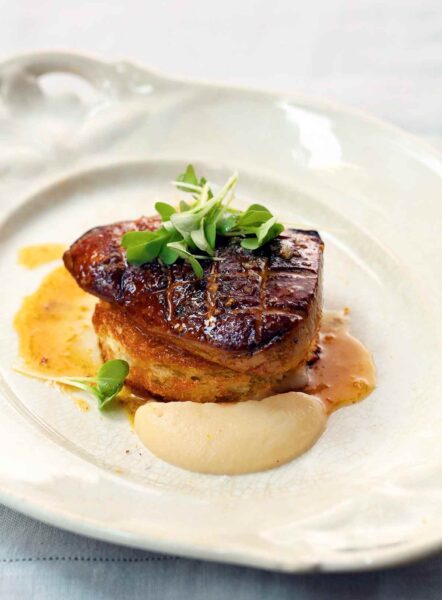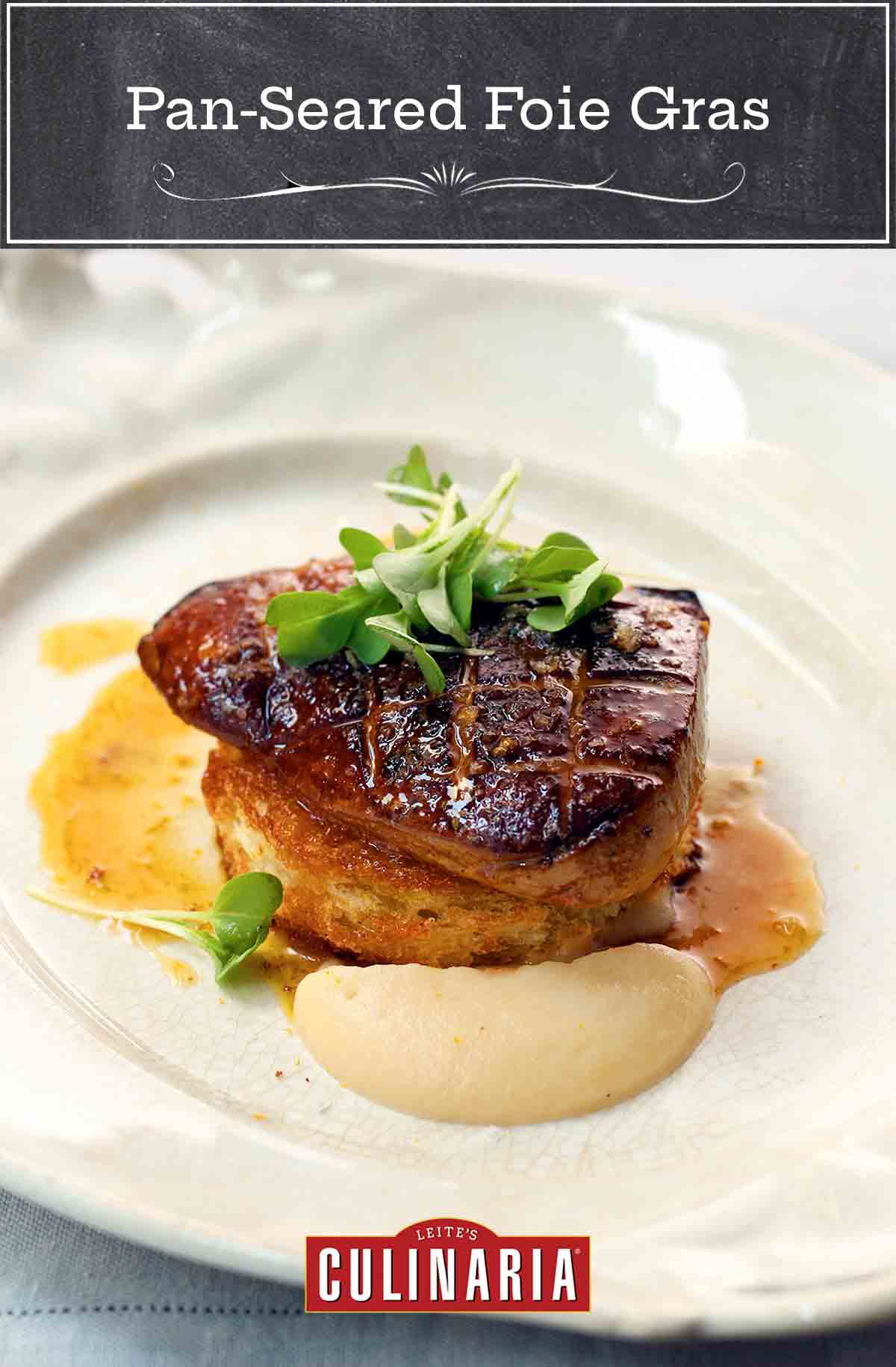
Jump To
This lovely pan-seared foie gras recipe is a little luxuriant. And not just in terms of it being made from rich foie gras. See, it calls for splashing some relatively pricey and perfectly sippable late-harvest wine into a pan and reducing it to a shimmery sauce. We gotta confess, this sauce makes an inspired complement to pan-seared foie gras on toasted brioche with mildly nutty mache and a tart Granny smith purée. We think you’ll go just as wobbly in the knees as we did when we first experienced this luxe little ensemble. Here’s how to make it.–David Leite
Wine Pairing Note
Chef Laurent Tourondel suggests you serve this pan-seared foie gras with a sweetish wine that boasts aromas of dried peaches and candied citrus, such as Seyval Late Harvest “Romance,” Clinton Vineyards out of Hudson Valley, New York.
Want to Save This?

Pan Seared Foie Gras
Ingredients
For the apple purée
- 3 tablespoons (1 1/2 oz) unsalted butter
- 3 Granny Smith apples, peeled, cored, and thinly sliced
- 3/4 cup dry white wine
- 3 tablespoons quince jelly or quince paste
For the pan-seared foie gras and wine sauce
- Six (4-oz) pieces grade A foie gras, preferably Hudson Valley foie gras
- Sea salt and freshly ground black pepper
- 1 cup fresh grapefruit juice
- 1/2 cup late-harvest Chardonnay
- Zest from 1/2 orange, preferably organic
- 1/4 teaspoon finely chopped rosemary leaves
- 1 1/2 teaspoons unsalted butter
For the assembly
- Six (1/2-inch-thick) slices brioche
- 1/2 cup mâche, (optional)
Instructions
Make the apple purée
- Melt the butter in a medium sauté pan over medium heat. When the butter begins to foam, add the apples, wine, and jelly. Cook, stirring frequently, until the apples are tender, about 5 minutes. Transfer the mixture to a blender and purée until smooth. Set aside at room temperature.
Cook the pan-seared foie gras and wine sauce
- Place a large sauté pan over medium-high heat. Using a paring a knife, gently score the foie gras slices with a diagonal pattern on 1 side. Season to taste with salt and pepper. Place 3 slices in the pan and sear until golden brown, about 2 minutes. Reduce the heat slightly, turn the foie gras over, and cook for an additional 2 minutes. Transfer to a plate and set aside to rest. Wipe the pan clean and repeat with the remaining 3 slices of foie gras.
- Pour the excess pan drippings out of the pan, leaving just a thin film in the pan and reserving 3 tablespoons of drippings to add to the reduction. Deglaze the pan with the grapefruit juice over medium-high heat, scraping up any browned bits with a wooden spoon. Simmer until the juice is reduced by half, about 2 minutes. Add the Chardonnay, orange zest, rosemary, and the reserved pan drippings and simmer for 1 minute. Add the butter, remove from the heat, and whisk until well combined. Season the reduction to taste with salt and pepper.
Assemble and serve
- Preheat the broiler.
- Using a 3-inch round cookie cutter, cut the brioche into rounds and place them on a baking sheet. Toast the brioche rounds under the broiler until golden brown, about 1 minute per side.
- Place the brioche toasts in the center of 6 serving plates. Lay the foie gras slices on top of the brioche. Spoon the apple purée around the foie gras, drizzle with the grapefruit reduction, and, if desired, scatter the mâche leaves over the top.
Notes
Where To Buy Foie Gras
Chef Laurent Tourondel, the mastermind behind this recipe, asserts that Hudson Valley Foie Gras provides some of the best foie gras in all the United States—and perhaps the world. Located in the lush Hudson Valley just a few hours north of Manhattan, the company specializes in Moulard duck livers.
Nutrition
Nutrition information is automatically calculated, so should only be used as an approximation.











Isn’t it better to sieve the grapefruit reduction before drizzling it over?
Yes, Vo, you definitely can pass the reduction through a sieve before drizzling if you prefer to avoid having any pieces of orange zest or rosemary on the plate.
Are you saying that the six pieces are a total of 4 oz or that each piece is 4 oz which would make it a total of 24 oz?
Hello, Lina. Yes, that would be six four-ounce pieces, for a total of 24 ounces.
what is saute pan?? Sorry for my dumb question, I am just began to learn french cuisine.
Hi Rama, a saute pan is just a large flat bottomed pan with straight sides as opposed to the sloped sides found in a skillet or frying pan. Good luck with your cooking adventures!